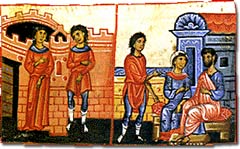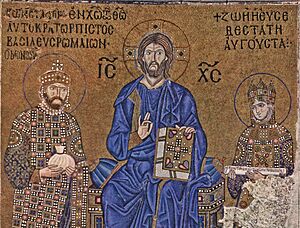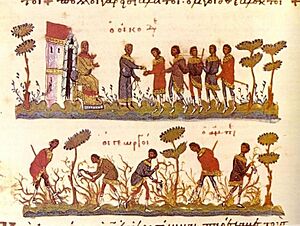Byzantine Greeks facts for kids

Medieval Greek marriage and family life.
|
|
| Regions with significant populations | |
|---|---|
| Byzantine Empire (esp. Asia Minor, Balkans) | |
| Languages | |
| Medieval Greek | |
| Religion | |
| Orthodox Christianity |
The Byzantine Greeks were Greek people who lived a long time ago, during the Middle Ages. They were also called Byzantines. They lived in a powerful empire called the Byzantine Empire, also known as the Eastern Roman Empire. This empire included places like Greece, Asia Minor (modern-day Turkey), and Cyprus. The Byzantine Greeks spoke a language called Medieval Greek. They kept their Greek culture alive, followed Roman laws, and practiced Eastern Christianity. Their society had many different kinds of people, including farmers, traders, teachers, soldiers, and priests.
Contents
Who Were the Byzantine Greeks?
The Byzantines used different names for themselves. They called themselves Romans (Romaioi). This was because they were the political heirs of the Roman Empire. They also called themselves Greeks (Graikoi) because they were descendants of the ancient Greeks. Finally, they called themselves Christians (Christianoi) because they believed in Jesus Christ. They used these names to mean the same thing. They also called anyone who was not Greek a "barbarian."
Life in Byzantine Greek Society
Byzantine Greek society had many different groups of people. These included the poor, farmers, soldiers, teachers, merchants, and priests.
Poor People and Farmers
There were two main groups of poor people. The ptochos were those who could not work. The penes were poor but still worked hard. Most Byzantine Greek farmers lived in villages. They often drank wine and ate foods like grains, beans, fish, bread, and olives. Many farmers also hunted, fished, or kept bees. Some were skilled workers like craftsmen, smiths, tailors, and shoemakers.
Soldiers and Teachers
Soldiers were chosen for military duty each year. They also worked as medics and technicians. Their way of life followed old Greek and Roman military traditions. Soldiers, like farmers, often ate a type of dried biscuit bread called a paximadion.

Education in the Byzantine Empire was based on ancient Greek traditions. It had three levels:
- Elementary school: For students aged six to ten years old.
- Secondary school: For students aged ten to sixteen years old.
- Higher education: For older students.
More people could read and write in the Byzantine Empire than in Western Europe. Elementary schools were common in towns and the countryside. Secondary schools were mostly in larger cities. Higher education was available at the University of Constantinople. In elementary schools, teachers used simple storybooks like Aesop's Fables. In secondary schools, students read ancient Greek texts like Homer's Iliad and Odyssey.
Women in Byzantine Society
The life of a Byzantine Greek woman had three main stages: girlhood, motherhood, and widowhood. Women usually did household chores and farm work. Poor women sometimes wore simple tunics without sleeves. Most women wore a veil called a "maphorion" to cover their hair. Wealthy women bought and wore expensive silk clothes and jewelry. Some women also worked outside the home as traders, church workers, or teachers.
Traders and Priests
Byzantine Greek traders traveled a lot. They created new ways to invest money, like the "chreokoinonia." Byzantine Greek priests were very connected to their communities. Unlike some other Christian priests, they were allowed to get married, except for bishops.
Related pages
Images for kids
-
Joshua shown as a soldier wearing armor and a sword (Hosios Loukas).
-
A page from a 5th or 6th century Iliad manuscript.
-
A gold coin (solidus) from Justinian II, made after 692.
-
King David wearing imperial purple robes (Paris Psalter).
-
The Entry of the Crusaders into Constantinople, a painting by Eugène Delacroix, 1840.
-
Map showing where different dialects of Greek, descended from Byzantine Greek, were spoken in 1923.
See also
 In Spanish: Griegos bizantinos para niños
In Spanish: Griegos bizantinos para niños











